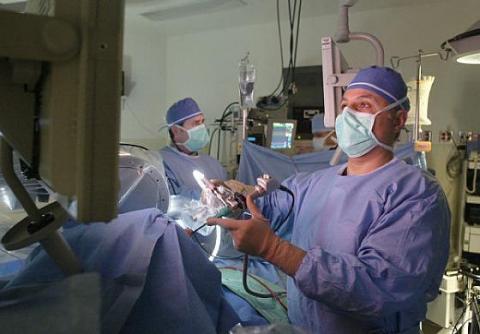LOS ANGELES--(BUSINESS WIRE)--Elizabeth Gitto, a 38-year-old, stay-at-home mom from Sherman Oaks, CA, is among the 3,000 Americans diagnosed each year with a little known brain tumor called an acoustic neuroma (AN) that sits near the nerve nearest the part of the brain that controls hearing. She suffered from intermittent hearing loss, ringing in the ears, vertigo, dizziness and headaches and it took doctors a year to finally discover the tumor. Her treatment options seemed limited and “truly scary” as removing the tumor is tricky and often results in patients losing their hearing.
She did her research, though, and uncovered studies conducted at the Skull Base Institute in LA that show patients undergoing the “keyhole” technique fared much better than their counterparts who underwent the traditional, invasive procedures favored by neurosurgeons.
Brain surgeon Hrayr Shahinian, M.D., medical director of the Skull Base Institute who has performed 6,000+ minimally invasive procedures including the keyhole technique, says that it involves making a dime-sized opening behind the ear and using an endoscope to remove the tumor. Unlike traditional forms of surgery, no metal retractors are used to push the brain aside thus reducing chances of brain damage and no massive incisions are necessary, which makes it safer. ANs are located near 2 nerves – one situated near the hearing canal and the other that controls facial expression. Standard surgery often results in a loss of hearing and permanent facial paralysis while such occurrences are less likely using the keyhole technique.
According to a study conducted by the Skull Base Institute:
- An astounding 94% of AN tumors were completely removed and 6% mostly removed using the keyhole procedure.
- 100% of patients experienced preservation of their facial nerve
- Hearing was preserved in 57% of keyhole patients while those undergoing more traditional invasive approaches fared less favorably (i.e., one such procedure, the translabyrinthine approach, results in total hearing loss in 100% of patients)
- No significant neurological complications occurred in any of the keyhole cases compared with up to 20% through traditional surgical options
- The keyhole procedure takes approximately 2 hours to perform while traditional surgery can take up to 12, hospital stays are significantly shorter (2 days vs. 10), and recovery time is dramatically shorter.
For more information visit www.skullbaseinstitute.com.

